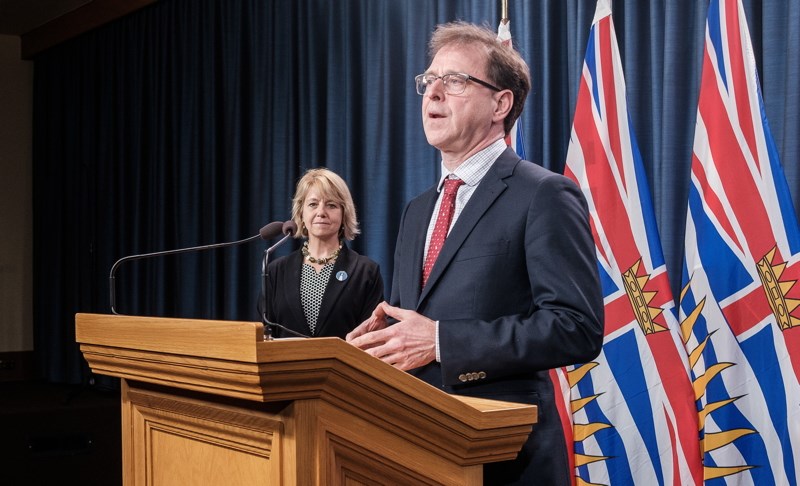Prohibitions on non-essential travel between the United States and saąúĽĘ´«Ă˝ “have to continue into the future,” says saąúĽĘ´«Ă˝â€™s health minister.
“saąúĽĘ´«Ă˝â€™s position could not be more crystal clear,” Health Minister Adrian Dix said Tuesday. “It cannot change now.”
Dix’s comments come as the federal government is planning stronger measures to deal with a looming influx of people arriving from the United States, a clear sign saąúĽĘ´«Ă˝ is bracing for the realities of life after lockdown while living next door to the world’s largest COVID-19 hotspot.
The gradual reopening of businesses and easing of mobility restrictions in both countries will likely mean an increase in cross-border traffic, and with it the need for additional steps to ensure new arrivals are adhering to self-isolation protocols, Prime Minister Justin Trudeau said Tuesday.
“We are looking at stronger measures to make sure that we’re following up appropriately on people who come over,” Trudeau said during his daily briefing outside his Rideau Cottage residence.
“As economic activity starts to ramp up, as restrictions get loosened across countries, it is likely that we see either a few more people returning home or a few more people trying to cross the border, and we need to make sure that the measures we bring forward are going to keep Canadians safe.”
The mutual bilateral ban on non-essential travel, an agreement that initially went into effect in March and was extended by an additional 30 days last month, is now scheduled to expire May 21.
Trudeau would not say whether he expects the restrictions to be extended a second time.
Provincial leaders, in particular Ontario’s Doug Ford, have made it clear they don’t want visitors from the U.S., currently home to more than a million active cases of COVID-19. The disease has killed more than 82,000 Americans, the highest death toll in any single country.
Dix spoke with his federal and provincial counterparts on Monday evening and, as saąúĽĘ´«Ă˝ Premier John Horgan has done, he expressed the province’s desire for the restriction on non-essential cross-border travel remain in place beyond May 21.
“It would be absolutely unacceptable after the enormous sacrifice people in saąúĽĘ´«Ă˝ have in place to take this risk right now,” Dix said.
As of Tuesday, there had been 2,360 confirmed cases of COVID-19 in saąúĽĘ´«Ă˝ and 131 deaths attributed to the virus.
Dr. Bonnie Henry, saąúĽĘ´«Ă˝â€™s provincial health officer, said she does not foresee a change to requirements that people self-isolate for 14 days upon entering saąúĽĘ´«Ă˝ from the U.S.
“We need to look at where we are, come the end of June into the summer, and see what measures can be put in place,” Henry said. “I think, right now, the only thing that I see at the borders that we need to address is looking at how we can facilitate family reunification. But again, I would see that in the context of people having to self-isolate when they come here.”
As things improve, both in the U.S. and in saąúĽĘ´«Ă˝, the province can look at having different conversations around the need for self-isolation, “but we’re not at that place yet,” she said.
Trudeau said ongoing talks between saąúĽĘ´«Ă˝ and the U.S., both on the border as well as other matters of mutual interest, have been positive and constructive, adding that saąúĽĘ´«Ă˝ will use an abundance of caution.
“Preventing transmission from outside of saąúĽĘ´«Ă˝ into saąúĽĘ´«Ă˝, once we have controlled the spread within saąúĽĘ´«Ă˝, will be an essential part of ensuring that we don’t fall back into a second wave that could be as serious as this wave we’re going through, or even more so,” Trudeau said.
“So we’re going to be very, very careful about reopening any international travel, including the United States, before we feel that it is time.”
U.S. President Donald Trump, meanwhile — trying to get re-elected in November on the heels of the worst economic collapse since the Great Depression — has been aggressively lobbying states to get residents back to work and refire the country’s economic engines.
The government’s recent rhetoric on the border, combined with a rare public acknowledgment Tuesday from the U.S. State Department of the continuing co-operation across North America, suggests the ongoing talks may have moved into a new phase.
“The United States appreciates saąúĽĘ´«Ă˝â€™s close and constant co-operation regarding the management of the border during this unprecedented crisis,” acting U.S. ambassador to saąúĽĘ´«Ă˝ Richard Mills said in an unsolicited statement Tuesday.
Deputy Secretary of State Stephen Biegun has been hosting weekly calls with his Canadian and Mexican counterparts since March 19 “to share best practices in responding to the unique and complex challenges presented by the global pandemic and planning for safely reopening our economies and commerce,” the State Department said.
Deciding what to do about the border is not only a matter of assessing the overall threat from the U.S., but also ensuring that the ability to test, track, isolate and quarantine is in place to properly deal with new arrivals, said Dr. Theresa Tam, saąúĽĘ´«Ă˝â€™s chief public officer of health.
“It is something we will have to watch really carefully so that it is not an issue that’s going to overwhelm our public health capacity,” said Tam, who urged “extreme caution” in deciding when and how to begin lifting travel restrictions.
“We need to be able to see what happens when we ease the domestic public health measures before we can essentially look at the international border easing up,” she said.
“The virus is in essentially all countries and jurisdictions of the world, and they’re all at different stages in their epidemiology, so part of that will be looking at that aspect of what’s going on in the other country.”
In the U.S., public health officials have also been urging a gradual, cautious approach — though whether the advice is being heeded remains an open question.
Ěý



